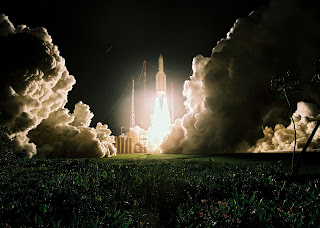Visiting the space station, and seeing the rockets and speaking with some scientists from ESA does raise a few important questions about our relationship with space. Here are the responses to some questions which I discussed with the head and 2nd in command of the VEGA launch campaign.
How does a rocket work?
Rockets are vehicles powered by a propellant and thrust. The type of rocket really depends on the use - military, space, scientific, or just for display e.g. fireworks. The principal remains the same though; an aerodynamic shaped vehicle is launched into the air by a principal thrust, like the rockets in the movies.
ESA has two principal rockets:
- VEGA - a small rocket without any kind of strap on booster. VEGA has three stages of solid rocket propellant, which will help it to lift off and enter a low orbit where it will deliver it’s small payload - satellites.|
- ARIANE 5 - A large rocket with two boosters on either side (one of which is basically the size of VEGA). The boosters work similarly to a simplified version of VEGA - large fuel containers with engines at the bottom. The ARIANE rocket itself has what is called a cryogenic main stage: a large tank full of liquid hydrogen and oxygen with a Vulcain engine - absolutely enormous engine - which powers the rocket into a low orbit where it can deliver it’s payload.
Vulcain engine:
(note that about 80% of a rocket is just solid fuel).
Hearing all this stuff about fuel and engines I couldn't help but think - why aren't we thinking outside the box? So I decided to ask about nuclear engines? Or renewable energy engines?
Silly me.... The response was a laugh and "please don't go there". The nuclear option is basically impossible because of the instability and explosiveness of nuclear devices. Already if a current rocket blows up it's a huge bang, if a nuclear rocket did it would be the equivalent of a small nuclear bomb... Although it was mentioned that nuclear engines had been a popular proposal in the '80s.
As for renewables, we're just not far enough down that road to get an energy intense, sustained and transportable enough for use in rockets aimed at getting into space.
How has rocket design changed in the last 50 years?
The basic idea of a rocket hasn't changed that much.. The designs now are more aerodynamic, but the shape hasn't evolved nearly as much as the content. The main evolutions in rocket design have been:
Engines: the early rockets (pre-space flight) were single engine/compartment. Meaning that they burnt out much faster. Also rockets today typically have boosters, which carry additional fuel, and help the rocket get up into the high atmosphere before breaking off, and leaving the rocket to enter orbit and deliver the payload. And finally the fuel content is completely different. ESA fine tunes each compartment's fuel content (it can take up to two weeks to fuel a single rocket as they are so big). Todays fuel is sometimes liquid and sometimes solid, depending on the rocket and compartment, but rocket fuel is very different from the stuff we put in our cars (which is basically what early rocket scientists were using).
What creates the clouds of smoke at the launch?
The smoke after launch, the darker smoke, is the burning of exhaust. Depending on the type of fuel burning and the consistency and engine the smoke will differ, but that's basically the gist.


No comments:
Post a Comment